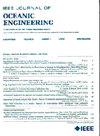基于密度的OFDM鲁棒信道估计改善水声通信
IF 5.3
2区 工程技术
Q1 ENGINEERING, CIVIL
引用次数: 0
摘要
由于受多普勒扩频、低信噪比(SNRs)、对复杂信道特性的普遍需求以及现实世界数据的稀缺性的影响,水声(UWA)通信面临着独特的挑战。准确的正交频分复用(OFDM)信道估计是确保在这种具有挑战性的环境中可靠传输数据的关键。在本研究中,我们介绍了专门用于UWA通信中OFDM信道估计的DenseNet估计器。在DenseNet结构中使用密集连接被证明在捕获复杂和动态UWA信道的复杂性方面是有利的。这种架构即使在试点数量有限的情况下也表现出了健壮性,使其与传统方法区别开来。DenseNet估计器在水印数据集上进行训练,利用实时变化信道脉冲响应的丰富性为准确的信道估计提供必要的多样性。独特的是,一旦经过训练,我们的DenseNet估计器无需额外的信道统计(如信噪比)即可运行,仅依赖于接收信号作为主要输入。这种方法在实际场景中提供了一种简化的、更直接的应用程序。我们的数值结果强调了DenseNet估计器的有效性:它始终优于传统方法,如最小二乘法、最小均方误差和全连接神经网络,记录的误码率提高高达96.3%、94.2%和40.0%。通过各种水印水下信道的性能评估,证明了DenseNet估计器在稳定和具有挑战性的环境中的适应性和鲁棒性。本文章由计算机程序翻译,如有差异,请以英文原文为准。
DenseNet-Based Robust Channel Estimation in OFDM for Improving Underwater Acoustic Communication
Underwater acoustic (UWA) communication presents unique challenges due to the unpredictable and dynamic nature of acoustic channels, influenced by Doppler spread, low signal-to-noise ratios (SNRs), and the general need for complex channel characteristics, coupled with a scarcity of real-world data. Accurate orthogonal frequency division multiplexing (OFDM) channel estimation is pivotal for ensuring reliable data transmission in such challenging environments. In this study, we introduce the DenseNet estimator, which is specifically used for OFDM channel estimation in UWA communication. The use of dense connectivity within the DenseNet structure proves to be advantageous in capturing the intricacies of the complex and dynamic UWA channels. This architecture, showcasing robustness even when there's a limited number of pilots, sets it apart from conventional methods. The DenseNet estimator is trained on the WATERMARK data set, leveraging the richness of real-time varying channel impulse responses to provide the necessary diversity for accurate channel estimation. Uniquely, once trained, our DenseNet estimator operates without necessitating additional channel statistics like SNR, relying solely on the received signal as its primary input. This approach offers a simplified and more direct application in real-world scenarios. Our numerical results underscore the DenseNet estimator's efficacy: It consistently outperforms traditional methods such as least square, minimum mean square error, and fully connected neural network, recording improvements of up to 96.3%, 94.2%, and 40.0% in bit error rate. Performance assessments across various watermark underwater channels demonstrate the DenseNet estimator's adaptability and robustness in both stable and challenging environments.
求助全文
通过发布文献求助,成功后即可免费获取论文全文。
去求助
来源期刊

IEEE Journal of Oceanic Engineering
工程技术-工程:大洋
CiteScore
9.60
自引率
12.20%
发文量
86
审稿时长
12 months
期刊介绍:
The IEEE Journal of Oceanic Engineering (ISSN 0364-9059) is the online-only quarterly publication of the IEEE Oceanic Engineering Society (IEEE OES). The scope of the Journal is the field of interest of the IEEE OES, which encompasses all aspects of science, engineering, and technology that address research, development, and operations pertaining to all bodies of water. This includes the creation of new capabilities and technologies from concept design through prototypes, testing, and operational systems to sense, explore, understand, develop, use, and responsibly manage natural resources.
 求助内容:
求助内容: 应助结果提醒方式:
应助结果提醒方式:


